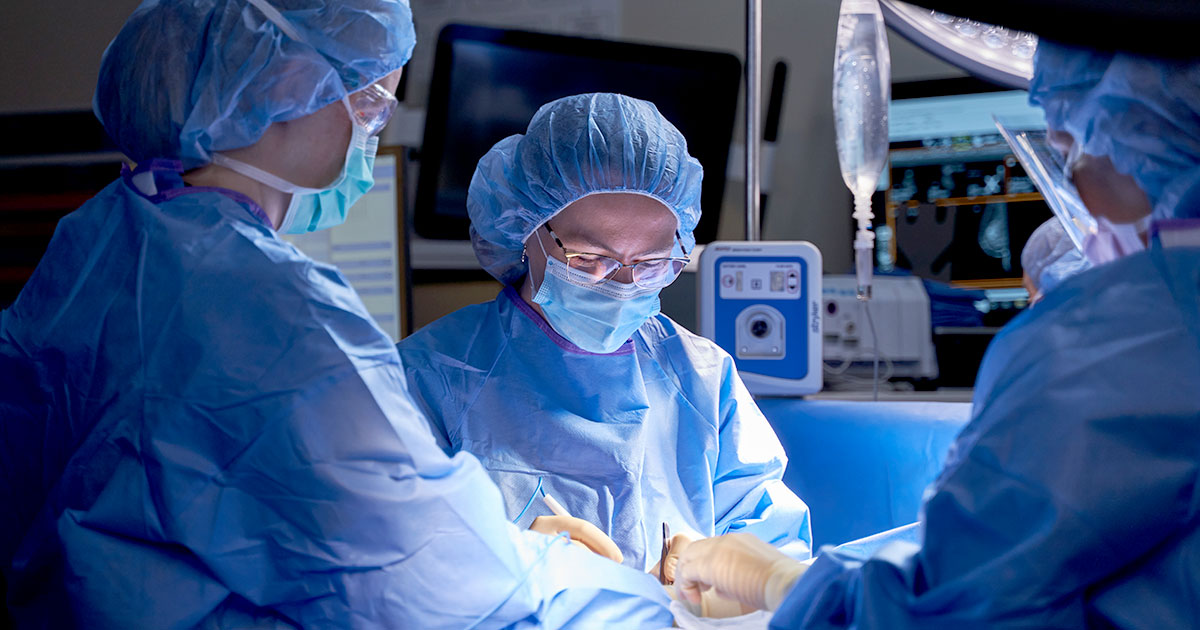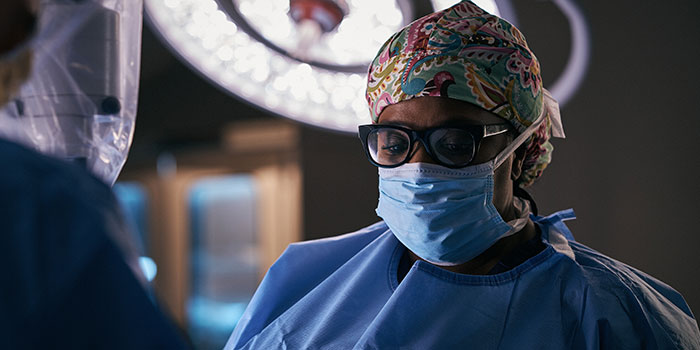
When a cancer patient undergoes surgery, the procedure typically has one goal: to remove the tumor and make the cancer go away. But it’s hardly ever that simple.
Cancer surgeries are often extraordinarily complex procedures that may require hours of delicate work navigating around organs and blood vessels. Surgeons also must be concerned about scarring, pain and other post-operative challenges that may affect the patient’s quality of life. Head and neck cancer surgeries, for instance, may be extremely complicated and involve not just removing as much of the cancer as possible but also maintaining functions inside the mouth and throat, such as speaking and swallowing.
“It's a very delicate part of the body,” says Beomjune Kim, DMD, MD, Head and Neck and Microvascular Reconstructive Surgeon at City of Hope Atlanta. “So, the surgeries are also very delicate. And it's an area people can see, so, I have to think about recreating their facial structures. Also, it's a very functional part of the body. You have to talk, eat. And so, I have to think about functional reconstruction as well.”
Dr. Kim says some of the surgical procedures he performs may take up to 12 hours to complete.
Nearly every cancer patient with a solid tumor or tumors is likely to undergo some form of surgery during his or her treatment journey. And while surgery is often a first-line treatment for cancer, it may be preceded (neoadjuvant) or followed (adjuvant) by another treatment—usually chemotherapy and/or radiation therapy to either:
- Shrink the tumor before surgery to help make it easier to remove
OR
- Kill any microscopic cancer cells that may have been left behind after surgery
“For most situations, we need to do something besides surgery,” says David J. Winchester, MD, Surgical Oncologist at City of Hope Chicago and our Outpatient Care Center in Gurnee, Illinois. “The adjuvant therapy or drugs often improve our ability to accomplish our goals.”
Some patients can’t undergo cancer surgery. They may not be able to tolerate surgery if they’re in poor health or have cardiac or pulmonary diseases, for example. Surgery also may not be an option if the cancer is entwined in vital organs, the brain or spinal cord.
Regardless of the circumstances, it’s vital that patients fully understand the scope and goal of the cancer surgery.
“What surgery can and cannot accomplish is often misunderstood by patients,” says Stephen P. Ray, MD, Medical Director of the Breast Cancer Center at City of Hope Chicago.” Our goal is to evaluate the individuals unique tumor characteristics and explain the role of surgery, as part of a larger treatment strategy. Making sure the patient understands the evidence-based options is critical for sound decision making.”
The differences in cancer surgeries range from removing tumors for diagnosis and staging, to removing just enough to improve a patient's quality of life. In this article, we’ll explore the different types of cancer surgery:
- Diagnostic surgery
- Curative surgery
- Prophylactic surgery
- Debulking surgery
- Palliative surgery
- Reconstructive surgery
- Supportive surgery
- Surgical techniques
If you’ve been diagnosed with cancer and would like to learn more about our treatment options, or if you’re interested in a second opinion on your diagnosis and treatment plan, call us or chat online with a member of our team.
Diagnostic surgery
A biopsy is a surgical procedure designed to diagnose a tumor’s type and stage. The operation may range from an outpatient procedure performed with a small needle that collects a sample of a tumor, to a major procedure that requires anesthesia and stitches. Biopsies may be performed during other types of surgery and as part of an initial diagnosis, or to help gauge the progression of the disease. In some cases, lymph nodes and organs around the cancer may be biopsied so they can be examined under a microscope to determine the extent of the disease and whether it’s spread.
Curative surgery
The goal here is to leave the patient with no evidence of disease. This surgery may be performed when cancer is found in only one part of the body and evidence suggests it hasn’t spread locally or metastasized to other areas of the body. Patients with stage 1 colorectal cancer, for instance, may undergo a primary surgery that removes all evidence of disease and requires no further treatments.
Still, it’s typically impossible for a surgeon to know whether all the cancer has been removed during the surgery, even if they are aggressive in removing margins, the seemingly healthy tissue around the perimeter of the tumor. That’s why adjuvant treatments may be necessary after surgery.
“We can take out the visible, tangible tumor,” Dr. Ray says. “But then we may have to deal with the microscopic cells that we can't see. And that's where systemic therapy and radiation therapy plays a critical role.”
Prophylactic surgery
Some patients opt for surgery even if they don't have cancer, because they have a family history of the disease or carry a gene mutation that raises their cancer risk. For example, women with an inherited mutation in their BRCA1 or BRCA2 genes are at a higher risk of breast cancer and ovarian cancer. They may choose to have a prophylactic mastectomy and/or have their ovaries and fallopian tubes removed to reduce their cancer risk.
Actress Angelina Jolie, perhaps the most high-profile prophylactic surgery patient, chose to have a double mastectomy in 2013 and later had her ovaries and fallopian tubes removed after learning she carried a mutated BRCA1 gene. Jolie's mother died at 56 of ovarian cancer. Your doctor may recommend genetic counseling and testing to help with the decision on whether to have surgery.
After her sister was diagnosed with breast cancer in 2019, for example, Marnee Spierer, MD, Chief of Staff at City of Hope Phoenix, visited with a genetic counselor to undergo a risk assessment. And while she didn’t carry a known genetic mutation that put her at high risk, her family history and other factors led to her decision to have a risk-reducing double mastectomy.
“There were several other parts of my life, along with my obvious family history, that put me at an unacceptable (for me) high risk of developing breast cancer,” she writes in a CancerCenter 360 blog. “The bottom line is it’s very important to know your own risk for breast cancer. It is not as simple as whether you’re a gene carrier or not.”
Debulking surgery
These procedures are intended to reduce the size of a tumor or remove visible masses, often prior to another treatment, such as radiation therapy or chemotherapy. This type of surgery may also be performed just prior to hyperthermic intraperitoneal chemotherapy (HIPEC), a treatment—typically for advanced colorectal, ovarian or appendix cancer—in which a surgical oncologist delivers a heated chemotherapy solution directly to the abdomen after removing multiple tumors from the area.
Palliative surgery
As with any type of palliative care, the goal of these surgeries is to relieve discomfort and improve quality of life. For example, surgery may be performed to remove a blockage in the colon or an obstruction in the lungs. Palliative surgeries also include those to install a stent to alleviate a blockage or obstruction or to administer a nerve block to help relieve pain.
Reconstructive surgery
As its name suggests, reconstructive surgery is intended to rebuild or restore a part of the body that has been disfigured by cancer or the surgery to remove it. These procedures are especially common after surgery to remove breast or head and neck cancers.
Supportive surgery
These surgeries are performed to insert catheters, ports or devices that allow patients to receive medication directly into the bloodstream rather than having to receive repeated injections.
Surgical techniques
Doctors have a variety of tools at their disposal to use during surgery. The technique or technology they choose depends on multiple factors, including the type of surgery, the type of cancer and the surgeon’s training and certifications.
Surgical procedures include:
- Laser surgery, which uses a focused beam of light to remove tissue
- Microsurgery, such as Mohs surgery to remove skin cancer, which is performed at a microscopic level and may also be used to repair damaged lymph vessels that may cause lymphedema
- Cryosurgery, which kills cancer cells with freezing temperatures
- Electrosurgery, which uses an electric charge to destroy cancer cells and cauterize the area to stop bleeding
“Even in the holding area before the surgery, someone will say something that tells me that they really have misperceived what's going to happen,” Dr. Ray says. “I've actually canceled their surgery until we could sort it out and make sure that they were real clear about what we’re going to do and why we’re going to do it.”
If you’ve been diagnosed with cancer and would like to learn more about our treatment options, or if you’re interested in a second opinion on your diagnosis and treatment plan, call us or chat online with a member of our team.



